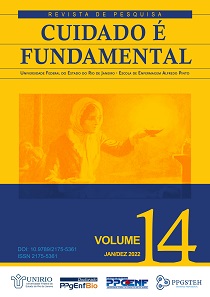Risk factors for recurrence of suicide attempt
DOI:
https://doi.org/10.9789/2175-5361.rpcfo.v14.11929Keywords:
Risk factors, Recidivism, Suicide, Attempted, SuicideAbstract
Objective: to analyze risk factors for recurrence of suicide attempt in people treated at the Emergency Care Unit in Assis, SP, Brazil. Method: quantitative study, participants who attempted suicide and attended at the reference unit. Individual interviews took place between December 2017 and November 2019. Divided into first-time suicide attempters and repeat offenders. Fisher's exact test, t-Student test for two samples and Multiple Logistic Regression Analysis were used. Results: 113 participants, being 80 (70.8%) repeat offenders, as they stated a previous history of suicide attempt and 33 (20.2%) being the first time. Conclusion: The age group from 20 to 47 years old, the self-perception of experiencing negative family relationships, the existence of mental disorder, the existence of chronic non-communicable diseases and people without a history of suicide attempt in the family were the risk factors associated with statistics for the occurrence of recidivism in suicide attempts.
Downloads
References
World Health Organization (WHO). Live life: an implementation guide for suicide prevention in countries. [Internet]. 2021 [cited 2021 oct 1]. Available from: https://www.who.int/publications/i/item/9789240026629
World Health Organization (WHO). Suicide worldwide in 2019: global health estimates. [Internet]. 2021 [cited 2021 oct 1]. Available from: https://www.who.int/publications/i/item/9789240026643
Ministério da Saúde (BR). Boletim epidemiológico: 2021 [Internet]. Brasília: Ministério da Saúde [acesso em 1 de outubro 2021]. Disponível em: https://www.gov.br/saude/pt-br/centrais-de-conteudo/publicacoes/boletins/boletins-epidemiologicos/edicoes/2021/boletim_epidemiologico_svs_33_final.pdf
Silva DA, Marcolan JF. Suicide attempts and suicide in Brazil: An epidemiological analysis. Florence Nightingale J Nurs. 2021 [cited 2021 dez 10];29(3). Available from: https://doi.org/10.5152/FNJN.2021.21035
Marcolan JF, Silva DA. O comportamento suicida na realidade brasileira: aspectos epidemiológicos e da política de prevenção. Rev. M. 2019 [acesso em 14 de junho 2021];4(7). Disponível em: https://doi.org/10.9789/2525-3050.2019.v4i7.31-44
Vásquez-Escobar L, Benítez-Camargo S. Intento suicida: un análisis municipal de factores asociados 2012-2017. Hacia promoc. Salud. 2021 [cited 2021 dez 10];26(2). Available from: https://doi.org/10.17151/hpsal.2021.26.2.6
Silva DA, Marcolan JF. O impacto das relações familiares no comportamento suicida. Res., Soc. Dev. 2021 [acesso em 1 de outubro 2021];10(2). Disponível em: https://doi.org/10.33448/rsd-v10i2.12349
Bachmann S. Epidemiology of Suicide and the Psychiatric Perspective. Int J Environ Res Public Health. 2018 [cited 2021 oct 1];15(7). Available from: https://doi.org/10.3390/ijerph15071425
Wayland S, Coker S, Maple M. The human approach to supportive interventions: The lived experience of people who care for others who suicide attempt. Int J Ment Health Nurs. 2021 [cited 2021 oct 1];30(3). Available from: https://doi.org/10.1111/inm.12829
Irigoyen-Otiñano M, Puigdevall-Ruestes M, Mur-Laín M, González-Pinto A, Portella MJ, Baca-García E, et al. Absence of association between the level of lethality and the recidivism of suicide attempts in a Spanish province. Actas Esp Psiquiatr. 2019 [cited 2021 oct 1];47(5). Available from: https://pubmed.ncbi.nlm.nih.gov/31648340/
Witt K, Milner A, Spittal MJ, Hetrick S, Robinson J, Pirkis J, et al. Population attributable risk of factors associated with the repetition of self-harm behaviour in young people presenting to clinical services: a systematic review and meta-analysis. Eur Child Adolesc Psychiatry. 2019 [cited 2021 oct 1];28. Available from: https://doi.org/10.1007/s00787-018-1111-6
Chai Y, Luo H, Yip PSF. Prevalence and risk factors for repetition of non-fatal self-harm in Hong Kong, 2002–2016: A population-based cohort study. Lancet Reg Health West Pac. 2020 [cited 2021 oct 1];2. Available from: https://doi.org/10.1016/j.lanwpc.2020.100027
Golay P, Ostertag L, Costanza A, Van der Vaeren B, Dorogi Y, Saillant S, et al. Patients with first versus multiple episodes of self-harm: how do their profiles differ? Ann Gen Psychiatry. 2021 [cited 2021 dez 10];20. Available from: https://doi.org/10.1186/s12991-021-00351-5
Liu B-P, Lunde KB, Jia C-X, Qin P. The short-term rate of non-fatal and fatal repetition of deliberate self-harm: A systematic review and meta-analysis of longitudinal studies. J Affect Disord. 2020 [cited 2021 dez 10];273. Available from: https://doi.org/10.1016/j.jad.2020.05.072
von Elm E, Altman DG, Egger M, Pocock SJ, Gøtzsche PC, Vandenbroucke JP. The Strengthening the Reporting of Observational Studies in Epidemiology (STROBE) Statement: guidelines for reporting observational studies. Int J Surg. 2014 [cited 2021 dez 10];12(12). Available from: https://doi.org/10.1016/j.ijsu.2014.07.013
Pinheiro TP, Warmling D, Coelho EBS. Caracterização das tentativas de suicídio e automutilações por adolescentes e adultos notificadas em Santa Catarina, 2014-2018. Epidemiol. Serv. Saúde. 2021 [acesso em 10 de dezembro 2021];30(4). Disponível em: https://doi.org/10.1590/S1679-49742021000400026
Otzen T, Fuentes N, Wetzel G, Henríquez C, Antúnez Z. Suicidabilidad y apoyo social percibido en estudiantes universitarios con enfermedades crónicas no transmisibles. Ter. psicol. (En línea). 2020 [cited 2021 dez 10];38(1). Available from: https://dx.doi.org/10.4067/S0718-48082020000100119
Tang S, Ports KA, Stone DM, Lin HC. The mediating role of internalizing and externalizing symptoms in the association between child neglect and suicide attempt in adulthood. Int J Contr Saf Promot. 2021 [cited 2021 dez 10];29. Available from: https://doi.org/10.1080/17457300.2021.2007406
McClellan C, Ali MM, Mutter R. Impact of Mental Health Treatment on Suicide Attempts. J Behav Health Serv Res. 2021 [cited 2021 dez 10];48(1). Available from: https://doi.org/10.1007/s11414-020-09714-4
Uğur K, Polat H. The relationship of suicidal ideation with psychological pain and anger rumination in patients with major depressive disorder. Arch Psychiatr Nurs. 2021 [cited 2021 dez 10];35(5). Available from: https://doi.org/10.1016/j.apnu.2021.06.012
Rogers ML, Joiner TE, Shahar G. Suicidality in Chronic Illness: An Overview of Cognitive–Affective and Interpersonal Factors. J Clin Psychol Med Settings. 2021 [cited 2021 dez 10];28(1). Available from: https://doi.org/10.1007/s10880-020-09749-x
Huh Y, Kim SM, Lee JH, Nam GE. Associations between the type and number of chronic diseases and suicidal thoughts among Korean adults. Psychiatry Res. 2021 [cited 2021 dez 10];296. Available from: https://doi.org/10.1016/j.psychres.2020.11
Onyeka IN, Maguire A, Ross E, O'Reilly D. Does physical ill-health increase the risk of suicide? A census-based follow-up study of over 1 million people. Epidemiol Psychiatr Sci. 2020 [cited 2021 dez 10];29. Available from: https://doi.org/10.1017/S2045796020000529
Ahmedani BK, Peterson EL, Hu Y, Rossom RC, Lynch F, Lu CY, et al. Major Physical Health Conditions and Risk of Suicide. Am J Prev Med. 2017 [cited 2021 dez 10];53(3). Available from: https://doi.org/10.1016/j.amepre.2017.04.001
Conti C, Mennitto C, Di Francesco G, Fraticelli F, Vitacolonna E, Fulcheri M. Clinical Characteristics of Diabetes Mellitus and Suicide Risk. Front Psychiatry. 2017 [cited 2021 dez 10];8. Available from: https://doi.org/10.3389/fpsyt.2017.00040
Rihmer Z, Gonda X, Torzsa P, Kalabay L, Akiskal HS, Eory A. Affective temperament, history of suicide attempt and family history of suicide in general practice patients. J Affect Disord. 2013 [cited 2021 dez 10];149(1-3). Available from: https://doi.org/10.1016/j.jad.2013.02.010
Fornaro M, Grunebaum MF, Burke AK, Mann JJ, Oquendo MA. Comparison of familial and non-familial suicidal behaviors among people with major depressive disorder: Testing the discriminative predicting role of high-yield clinical variables. J Psychiatr Res. 2018 [cited 2021 dez 10];102. Available from: https://doi.org/10.1016/j.jpsychires.2018.02.021
Muniz JPC, Finger BK, Davi WS, Araújo KSS, Côrtes MA. Mental vulnerability and suicide by contagion during the academic experience. Rev Med (São Paulo). 2021 [acesso em 12 de dezembro 2021];100(4). Disponível em: http://dx.doi.org/10.11606/issn.1679-9836.v100i4p351-357
Spillane A, Matvienko-Sikar K, Larkin C, Arensman E. How do people experience a family member’s high-risk self-harm? An interpretative phenomenological analysis. Arch Suicide Res. 2020 [cited 2021 dez 10];24(sup1). Available from: https://doi.org/10.1080/13811118.2019.1574248
Rezaie L, Schwebel DC. Psychological needs of the families of patients who attempted suicide by self-immolation: An overlooked issue. Burns. 2019 [cited 2021 dez 10];45(8). Available from: https://doi.org/10.1016/j.burns.2019.08.013
Published
Versions
- 2022-11-29 (2)
- 2022-11-28 (1)
How to Cite
Issue
Section
License
Copyright (c) 2022 Revista de Pesquisa Cuidado é Fundamental Online

This work is licensed under a Creative Commons Attribution-NonCommercial-NoDerivatives 4.0 International License.
TRANSFER AGREEMENT COPYRIGHT I transfer copyright of the article to the Journal of Care Survey is Fundamental - Online - RPCF, so it is accepted due to electronic publishing. The copyright includes the right to reproduce in whole or in part by any means, distributing that article, including figures, photographs, and any translations. The author can also print and distribute copies of your article, stating that since the rights belong to RPCF. I declare that this manuscript is original and has not been submitted for publication, in whole or in part to other online journals or not, so BMMC in the Annals of scientific events or book chapters.






























